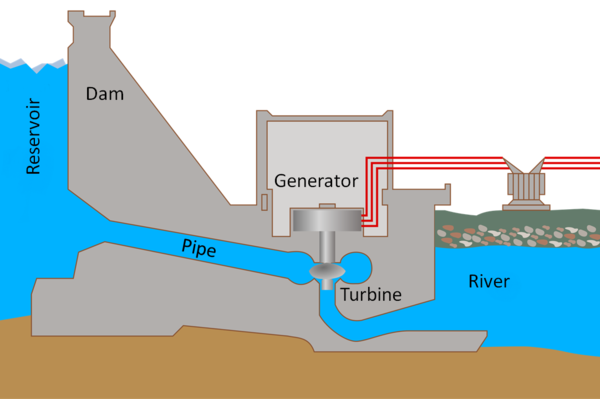Difference between revisions of "Hydroelectric"
(→Power) |
|||
| Line 20: | Line 20: | ||
: 4. The turbine causes a generator to spin. | : 4. The turbine causes a generator to spin. | ||
: 5. The generator makes an electrical current. | : 5. The generator makes an electrical current. | ||
| + | |||
| + | ====Advantages==== | ||
| + | *Reliable source as it is built in places that do not suffer drought. | ||
| + | *Power provided can change at a moments notice by allowing more water through the turbines. | ||
| + | *Low running costs and no fuel cost. | ||
| + | |||
| + | ====Disadvantages==== | ||
| + | *Expensive to build. | ||
| + | *Require the flooding of a large area of land. | ||
| + | *Destroys habitat of some creatures. | ||
| + | *Blocks the migration of some river species. | ||
| + | *Can only be built in certain locations. | ||
Revision as of 09:52, 9 October 2018
Contents
Key Stage 3
Meaning
Hydroelectricity is an energy resource that uses the water flowing in rivers to generate electricity.
About Hydroelectricity
- Hydroelectricity is a renewable energy resource.
- Hydroelectricity has energy in the gravitational potential energy store of water that is flowing downhill.
Power
Hydroelectricity can be used to generate electricity.
| A diagram of a hydroelectric dam. |
- 1. Water flowing down a river is held back by a dam making a large reservoir.
- 2. Some water is allowed through pipes to flow downhill.
- 3. This water turns a turbine as it falls.
- 4. The turbine causes a generator to spin.
- 5. The generator makes an electrical current.
Advantages
- Reliable source as it is built in places that do not suffer drought.
- Power provided can change at a moments notice by allowing more water through the turbines.
- Low running costs and no fuel cost.
Disadvantages
- Expensive to build.
- Require the flooding of a large area of land.
- Destroys habitat of some creatures.
- Blocks the migration of some river species.
- Can only be built in certain locations.
